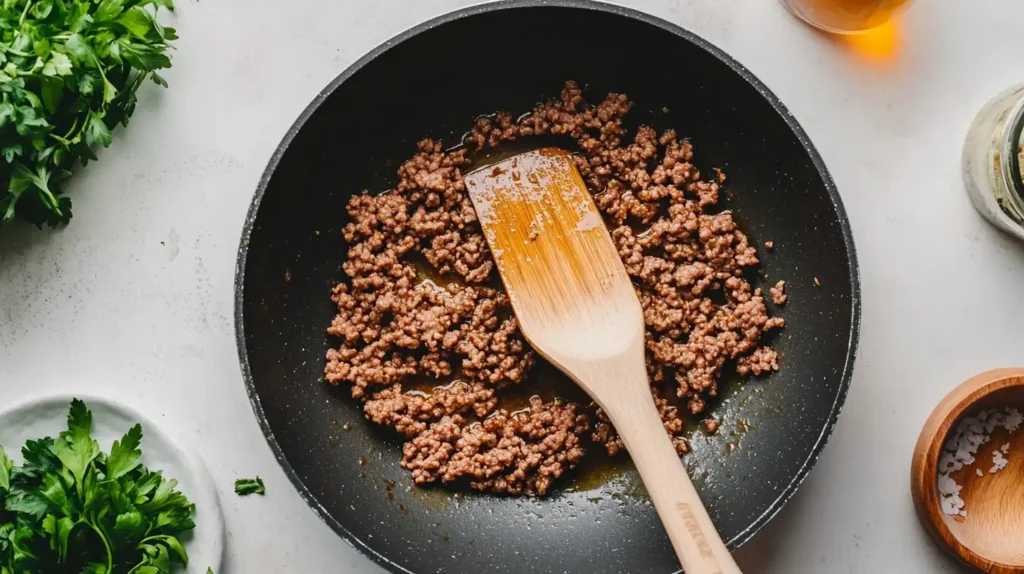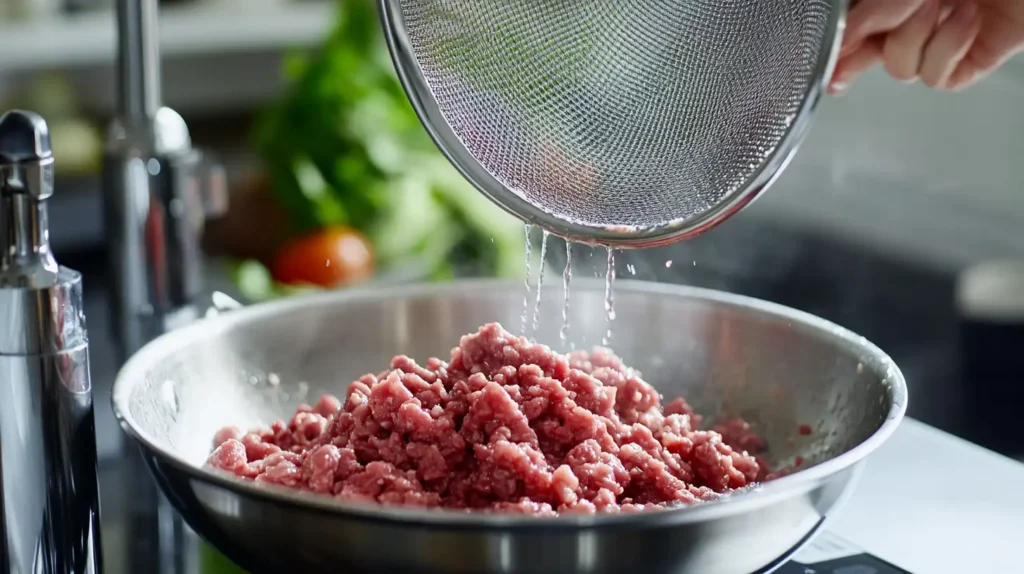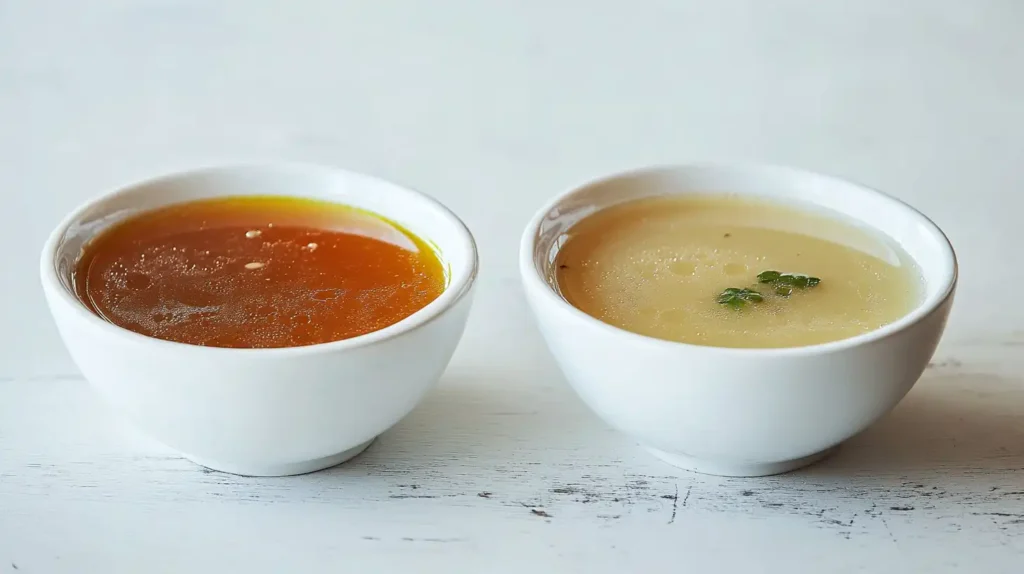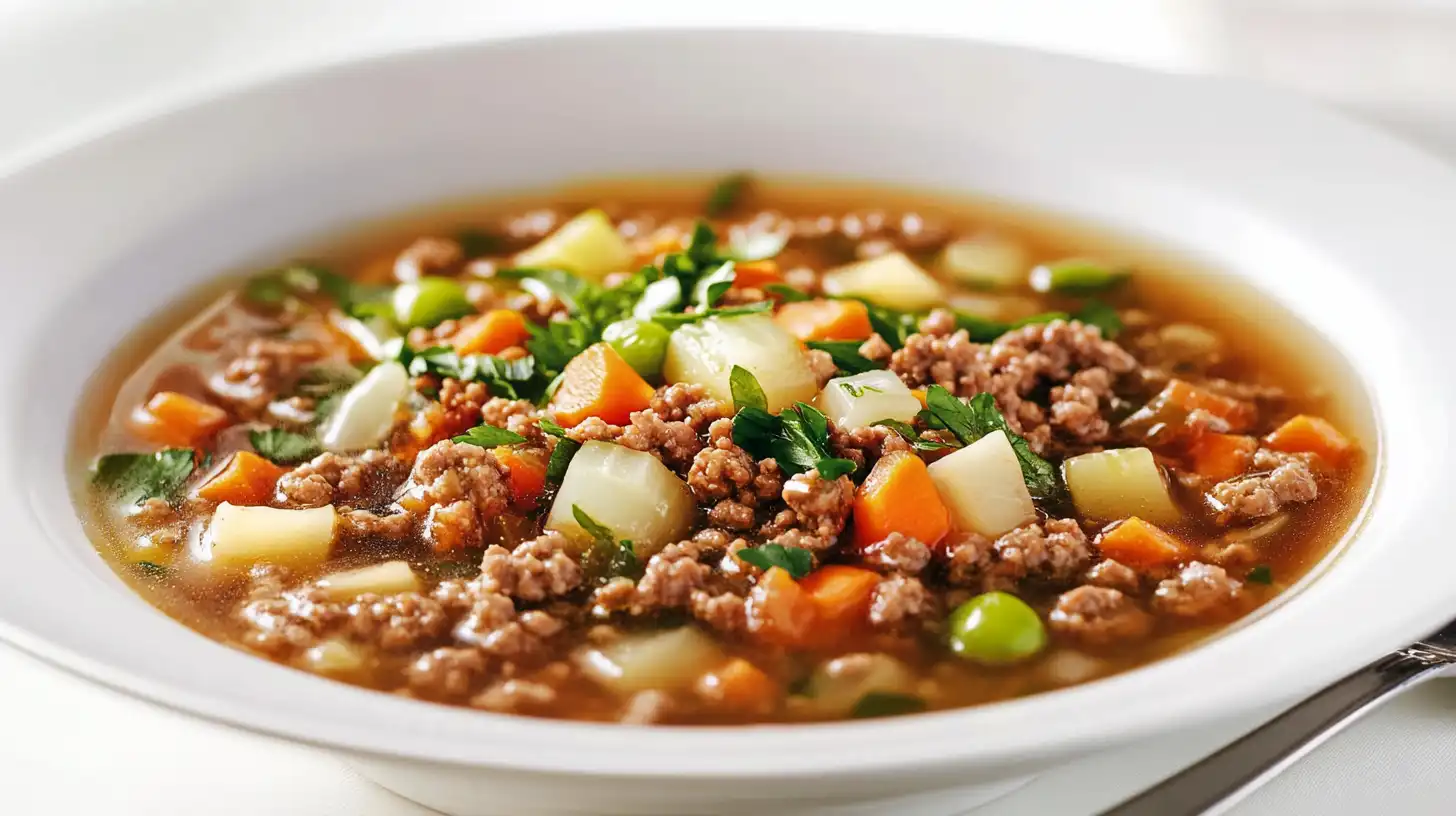Introduction
When making soup with ground beef, a common question is whether to remove the excess fat or let it enhance the dish’s flavor. Some cooks prefer draining to create a lighter broth, while others believe a small amount of fat adds richness. The right choice depends on several factors, including the beef’s fat content, the type of soup being prepared, and personal taste preferences.
Too much grease can leave a soup feeling heavy, creating an oily layer on top. On the other hand, removing all fat may take away depth of flavor, resulting in a less satisfying dish. Learning when and how to drain ground beef properly can make a noticeable difference in both taste and texture.
Certain soups benefit from a bit of retained fat, while others turn out best when the grease is completely removed. This guide covers the most effective draining techniques, how to balance flavor while reducing excess fat, and the impact of different cooking methods on the final dish.
When to Drain Hamburger Meat for Soup and When to Keep the Fat
The decision to drain hamburger meat for soup depends on achieving the right balance of flavor and texture. If you are wondering whether to remove the grease or keep some fat, the type of soup you are making will help determine the best approach.
For many home cooks, the choice of whether to drain hamburger meat for soup comes down to preference. Some soups require a clean, light broth, while others benefit from a bit of retained fat for added richness.
Another key factor in deciding whether to drain hamburger meat for soup is the fat content of the beef. Different types of ground beef contain varying amounts of fat, which can influence texture and taste.
How Fat Affects Texture and Flavor in Soup

Fat carries flavor and helps blend seasonings throughout the dish. It also keeps the meat moist and enhances the overall taste. However, too much grease in soup can cause an oily layer to float on top, making the dish feel heavy rather than well-balanced.
| Beef Fat Percentage | Best Use in Soup | Should It Be Drained? |
|---|---|---|
| Extra-lean (90/10 or higher) | Light, broth-based soups | No, very little fat is present |
| Lean (85/15) | Most soups, stews, and chili | Optional, based on preference |
| Regular (80/20) | Thick soups, casseroles, and chili | Yes, unless a richer texture is desired |
| High-fat (70/30) | Rarely used in soups | Yes, excess grease can overpower the dish |
For clear, broth-based soups, draining hamburger meat for soup helps maintain a fresh and clean taste. If the goal is a thicker soup, such as chili or stew, keeping a small amount of fat can contribute to the overall texture and depth of flavor.
How to Drain Hamburger Meat for Soup Without Losing Flavor
Removing excess grease from hamburger meat for soup can improve texture while still preserving the best flavors. The key is to drain the meat properly so that the dish remains balanced and flavorful.
Best Methods for Draining Hamburger Meat for Soup

- Colander Method: After cooking, place the ground beef in a colander over the sink and allow the fat to drain naturally. Shake the colander gently to remove excess grease.
- Paper Towel Method: Spread the cooked meat on a plate lined with paper towels. Lightly press another paper towel on top to absorb any remaining grease.
- Ladle Method: If the meat is already in the soup, use a ladle to skim the fat from the surface. This method works especially well for slow-cooked soups and stews.
Why Rinsing Cooked Hamburger Meat for Soup Can Reduce Flavor
Some people rinse cooked beef under hot water to remove grease, but doing so can wash away valuable flavors. Instead of rinsing, using proper draining methods helps control the amount of fat while keeping the dish flavorful and well-balanced.
Should You Drain Hamburger Meat for Soup Before Cooking?
Whether to drain hamburger meat for soup depends on the type of soup being made and the consistency you want to achieve. Some soups benefit from a small amount of fat to enhance texture, while others turn out better when excess grease is removed.

How Fat Affects Different Types of Soup
Fat behaves differently depending on whether the soup is broth-based or thick and creamy.
- In clear soups, such as vegetable beef soup or taco soup, too much fat can cause an oily layer to develop on the surface. Draining hamburger meat for soup before adding it helps maintain a light and fresh broth.
- In thick soups, such as cheeseburger soup or beef and potato chowder, a small amount of fat can add a smooth and rich texture. In these cases, draining is optional and depends on personal preference.
Finding the right balance between flavor and texture is key. A small amount of fat can enhance the dish, but too much can make the soup feel greasy.
For those wondering how different soups handle fat retention, our Hamburger Potato Soup Recipe offers a perfect example of how a small amount of fat enhances texture and flavor.
Does Draining Hamburger Meat for Soup Make It Healthier?
For those looking to reduce fat, draining hamburger meat for soup can lower calories while still keeping the dish flavorful.
When to Drain Hamburger Meat for Soup and When to Keep the Fat
The decision to drain hamburger meat for soup depends on finding the right balance between flavor and texture. Some soups require a clean, light broth, while others benefit from keeping a small amount of fat for richness. Understanding when to remove the grease and when to retain some fat can help create the best results.
For many home cooks, choosing whether to drain hamburger meat for soup comes down to personal preference. The fat content of the beef also plays a major role, as different types of ground beef contain varying amounts of fat that can impact the texture and taste.
How Fat Affects the Texture and Flavor of Hamburger Meat in Soup
Fat enhances flavor and helps distribute seasonings throughout the dish. It also keeps the meat moist and contributes to the overall taste. However, too much grease in soup can lead to an oily layer on the surface, making the broth feel heavy.
| Beef Fat Percentage | Best Use in Soup | Should It Be Drained? |
|---|---|---|
| Extra-lean (90/10 or higher) | Light, broth-based soups | No, very little fat is present |
| Lean (85/15) | Most soups, stews, and chili | Optional, based on preference |
| Regular (80/20) | Thick soups, casseroles, and chili | Yes, unless a richer texture is desired |
| High-fat (70/30) | Rarely used in soups | Yes, excess grease can overpower the dish |
For clear, broth-based soups, draining hamburger meat for soup helps maintain a clean and fresh taste. If the goal is a thicker soup, such as chili or stew, keeping a small amount of fat can add depth and enhance texture.
For those looking to create a healthier yet satisfying dish, consider using a natural thickener as discussed in our guide on what is a good thickener for potato soup to achieve the perfect consistency.
How to Drain Hamburger Meat for Soup Without Losing Flavor
Removing excess grease from hamburger meat for soup can improve texture while still preserving the best flavors. The key is to drain the meat properly so that the dish remains balanced and satisfying.
Best Methods for Draining Hamburger Meat for Soup
- Colander Method: After cooking, place the ground beef in a colander over the sink and allow the fat to drain naturally. Shake the colander gently to remove excess grease.
- Paper Towel Method: Spread the cooked meat on a plate lined with paper towels. Lightly press another paper towel on top to absorb any remaining grease.
- Ladle Method: If the meat is already in the soup, use a ladle to skim the fat from the surface. This method works well for slow-cooked soups and stews.
If you’re making a hearty stew and need guidance on consistency, check out our article on the difference between hamburger stew and hamburger soup to decide the best approach for your recipe.
Why Rinsing Cooked Hamburger Meat for Soup May Reduce Flavor
Some people rinse cooked beef under hot water to remove grease, but doing so can wash away valuable flavors. Instead of rinsing, using proper draining methods helps control the amount of fat while keeping the dish flavorful.
Should You Drain Hamburger Meat for Soup Before Cooking?
Deciding whether to drain hamburger meat for soup depends on the type of soup and the desired consistency. Some soups benefit from a small amount of fat to enhance texture, while others turn out better when excess grease is removed.
How Fat Affects Different Types of Hamburger Meat in Soup
Fat behaves differently depending on whether the soup is broth-based or thick and creamy.
- In clear soups, such as vegetable beef soup or taco soup, too much fat can cause an oily layer to develop on the surface. Draining hamburger meat for soup before adding it helps maintain a light and fresh broth.
- In thick soups, such as cheeseburger soup or beef and potato chowder, a small amount of fat can add a smooth and rich texture. In these cases, draining is optional and depends on personal preference.
Finding the right balance between flavor and texture is important. Keeping a small amount of fat can enhance the dish, but too much can make the soup feel greasy.
Does Draining Hamburger Meat for Soup Make It Healthier?
For those looking to reduce fat, draining hamburger meat for soup can lower calories while still keeping the dish flavorful.
How Much Fat Is Removed When Draining Hamburger Meat for Soup?
The amount of fat removed depends on the type of ground beef used and how well it is drained.
| Beef Fat Percentage | Calories Before Draining (per 3.5 oz) | Calories After Draining | Fat Removed |
|---|---|---|---|
| 80/20 | 275 | 220 | About 25% |
| 85/15 | 250 | 200 | About 20% |
| 90/10 | 215 | 190 | About 10% |
While draining helps reduce fat content, it does not remove all of it. Choosing extra-lean ground beef, such as 90/10 or higher, is a good option for those looking to make a lower-fat soup.
Conclusion
Do you drain hamburger meat for soup? This decision depends on several factors, including texture, fat content, and the type of soup being made. Lighter soups benefit from draining to keep the broth clear, while heartier dishes can use a little fat for added richness and depth.
If the fat is not drained before cooking, there are still ways to adjust the final texture. Skimming grease off the surface or chilling the soup to remove solidified fat can help control the amount of grease. Small seasoning adjustments after removing fat can also help balance the flavors.
When preparing homemade soup, consider whether draining the meat is the right choice for the dish. Cooking is about finding the right balance for each recipe. Whether draining or keeping some fat, the goal is always to enhance the taste and texture for the best possible result.

